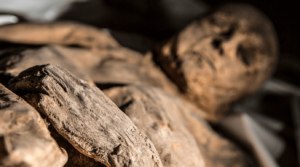The oldest-known sample of the smallpox-causing variola virus has been discovered in a 17th century child mummy found in a crypt beneath a Lithuanian church.
The virus was found within the DNA of the mummy and is believed to shorten the timeline for how long smallpox may have afflicted humans. Smallpox was believed to have affected humans as far back as ancient Egypt due to pockmarked scarring on 3,000 and 4,000 year old mummies.

Yet researchers have always had reservations about the belief, because the type of scarring found on the mummies is also associated with chickenpox or measles, according to study co-author Hendrik Poinar, director of the Ancient DNA Center at McMaster University in Hamilton, Ontario in Canada.
“This study suggests that all 20th century variola strains and our 17th century strain share a common ancestor in the late 16th century or early 17th century, which is more recent than we would expect for a virus that has supposedly been afflicting humans for millennia,” said Ana Duggan, lead study author and post-doctoral fellow at the McMaster Ancient DNA Center, to CNN. “However, this date correlates with historical records which show that there is little suggestion of epidemic smallpox in Europe before the 16th century.”

There’s uncertainty around the understanding of smallpox, how it developed and when it began to infect humans. The study is helping to establish an updated timeline of smallpox, especially during a time when exploration, migration and colonization could have helped to spread the virus, Duggan said.
The mummy itself has also been a source of uncertainty for the researchers who discovered it. The remains are of a child between two and four years old who was thought to have lived anywhere between 1643 and 1665, but the researchers are unsure of its gender due to the environment in which it was found.
The crypt itself has its own urban legends to contend with as well. Italian bio-anthropologist Dario Piombino-Mascali, a visiting researcher at Vilnius University in Lithuania, said the site was most likely disturbed.
The crypt has been rumored to have hosted the Napoleonic burial in 1812, holds uncategorized human remains and was even used as a bomb shelter during WWII. There was also a glass window installation that changed air flow into the crypt, and many mummies began to decompose, he said.

“The crypt and its stories are part of the local folklore, and a number of ghostly tales and other anecdotes began circulating already in the mid-19th century,” he said.
After extracting DNA from a skin sample, signs of the virus’s DNA were found. Duggan and her team then used a specific target-enrichment to remove molecules for a closer look with the permission to study the DNA from The World Health Organization.
Church officials have requested an investigation to allow for the documentation, study and curation of 23 human mummies in the crypt. Duggan said the mummies can provide insight into the time period via tissue and bone sample records.
“Ancient DNA gives us these extra internal calibration points, we get an extra dimension of time in our research, checking in on biology long after death,” Duggan said.
Tori Linville is a freelance writer and editor from Clarksville, Tennessee. When she isn’t writing or teaching, she’s faithfully watching her alma mater, the University of Alabama, dominate the football field.


![How To: ‘Fix’ Crepey Skin [Watch]](https://cdn.vitalupdates.com/wp-content/uploads/2017/05/bhmdad.png)












